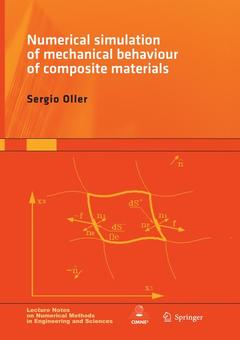Numerical Simulation of Mechanical Behavior of Composite Materials, 2015 Lecture Notes on Numerical Methods in Engineering and Sciences Series

An original mechanical formulation to treat nonlinear orthotropic behavior of composite materials is presented in this book. It also examines different formulations that allow us to evaluate the behavior of composite materials through the composition of its components, obtaining a new composite material. Also two multiple scale homogenization methods are given, one based on the analytical study of the cells (Ad-hoc homogenization) and other one, more general based on the finite element procedure applied on the macro scale (upper-scale) and in the micro scale (sub-scale).
A very general formulation to simulate the mechanical behavior for traditional composite structures (plywood, reinforced concrete, masonry, etc.), as well as the new composite materials reinforced with long and short fibers, nanotubes, etc., are also shown in this work.
Typical phenomena occurring in composite materials are also described in this work, including fiber-matrix debonding, local buckling offibers and its coupling with the overall buckling of the structure. Finally, several numerical examples that evaluates the qualities and capabilities of the general model formulated are offered in this book.
This book is intended for graduate engineering students who want to expand their knowledge of composite structures behavior.
Sergio Oller was appointed Full Professor at the School of Civil Engineering of the Technical University of Catalonia, Barcelona, Spain in 1988 and has worked there, as well as at the International Center for Numerical Methods in Engineering (CIMNE), up to the present.
He has also been Visiting Professor at the Civil Engineering Laboratory of the National University of Tucumán, Argentina and at the Department of Civil and Environmental Engineering of the University of California at Berkeley, USA.
Oller teaches “Strength of Materials and Structures”, a course in Civil Engineering, Geologic Engineering and Aeronautical Engineering; “Fracture Mechanics”, a course in Numerical Methods in Engineering and “Composite Materials” and “Non-linear Dynamics” courses in the Doctoral Program in Structural Engineering.
His research fields include: New Structural Materials, Industrial Casting Processes, Parallel Computing, Constitutive Models, Composites Materials, Fatigue, Earthquake Engineering and Dynamic of Structures.
His research fields include: New Structural Materials, Industrial Casting Processes, Parallel Computing, Constitutive Models, Composites Materials, Fatigue, Earthquake Engineering and Dynamic of Structures.Date de parution : 09-2016
Ouvrage de 220 p.
21x29.7 cm
Date de parution : 07-2014
Ouvrage de 220 p.
21x29.7 cm



